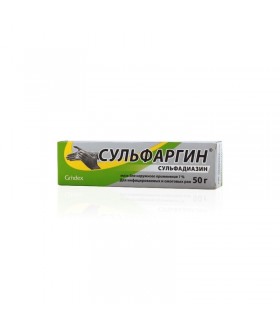




Security policy (edit with Customer reassurance module)

Delivery policy (edit with Customer reassurance module)

Return policy (edit with Customer reassurance module)
Sulfargin® - an antimicrobial bactericidal agent of broad-spectrum, belonging to the group of sulfonamides. The drug is active against gram-positive and gram-negative bacteria Escherichia coli, Proteus spp., Staphylococcus spp., Klebsiella spp.
The bactericidal properties of Sulfargin ointment are due to the activity of silver ions, which are released in the wound as a result of the dissociation of the silver sulfadiazine salt; the release of silver ions occurs gradually (moderate dissociation), ensuring the constancy of the antimicrobial effect. The bactericidal activity of silver ions is complemented by the bacteriostatic effect of sulfadiazine (also released during the dissociation of the silver salt of sulfadiazine).
Sulfargin is characterized by moderate osmotic activity and does not possess necrolytic properties.
When applied to the wound surface, about 10% sulfadiazine and 1% silver are absorbed into the peripheral and systemic circulation. Application to the extensive wound surface is accompanied by an increase in the concentration of sulfadiazine in the blood to 10-20 μg / ml.
Treatment of infected burn wounds, pressure sores, abrasions, skin ulcers, transplanted skin; and the prevention of their infection.
Wounds (includingnonhealing), trophic ulcers, bedsores, burns with mild exudation.
Pregnancy, lactation, children up to 1 year; pronounced deficiency of glucose-6-phosphate dehydrogenase, hypersensitivity to sulfanilamides. Sulfargin should not be used for the treatment of deep purulent wounds and burn surfaces with abundant exudation.
With care: renal / hepatic failure, deficiency of glucose-6-phosphate dehydrogenase (risk of hemolysis).
The drug is contraindicated in pregnancy and lactation.
1 g ointment contains:
active substance: silver sulfadiazine 10 mg;
Excipients: vaseline oil, propylene glycol, cetyl stearyl alcohol, glycerol monostearate 40-55, polysorbate 80, methyl parahydroxybenzoate, propyl parahydroxybenzoate, purified water.
Outwardly. After surgical treatment of the wound and removal of necrotic tissue, apply a thin layer (2-4 mm) of ointment (for dressing or open method) 1-2 times a day to the damaged surface.
The maximum single dose is 300 g. The treatment period is individual and depends on the nature of the disease and the effectiveness of the treatment used, in general cases lasts up to 3 weeks.
Applying ointment to the skin is painless, ointment does not stain clothes and underwear.
If you forget to use the drug, use as soon as possible and continue using as usual. Do not use a double dose if the previous time of use of the drug was missed.
If you feel that the effect of the drug is too strong or too weak, tell your doctor about it.
Burning and itching at the site of application, violation of skin pigmentation, skin allergic reactions, skin necrosis, erythema multiforme, interstitial nephritis, leukopenia, which is characterized mainly by a decrease in the number of neutrophils.
With long-term use on large wound surfaces: systemic side effects characteristic of sulfa drugs, including impaired blood formation (agranulocytosis, aplastic and hemolytic anemia, thrombocytopenia, leukopenia), skin and allergic reactions, including Stevens-Johnson syndrome and exfoliative dermatitis; dyspepsia, hepatitis, hepatocellular necrosis, impaired function of the central nervous system and toxic nephrosis.
The degree of absorption of the drug depends on the size of the burn surface and the degree of tissue damage.
Silver sulfadiazine may inactivate enzyme preparations used to cleanse a wound; therefore, the simultaneous use of these preparations is undesirable.
Store in a dark place at a temperature not higher than 25 ° C. Do not freeze.